There’s this trend that’s been going on for a while now, with companies giving improved products the “Pro” moniker. Rarely that reflects them being really meant for professionals. That applies to the HiFiMAN Deva Pro as well, although it does bring a lot of improvements compared to the previous generation: the new “stealth” magnets, the Bluemini R2R, the double input jacks, the silver-and-black colour scheme… HiFiMAN managed to create a better successor to a model that was already quite well received. Not an easy task!
Disclaimer: I got this unit for free from HiFiMAN. They retail for $329.
TL;DR: recap
| Pros |
Cons |
| + Very comfortable
+ Unbelievable microphone performance + ANC works well + Very good battery life |
– Bluemini R2R has a few quirks (e.g. volume of status messages) |
Rating: 9/10
Packaging & Accessories
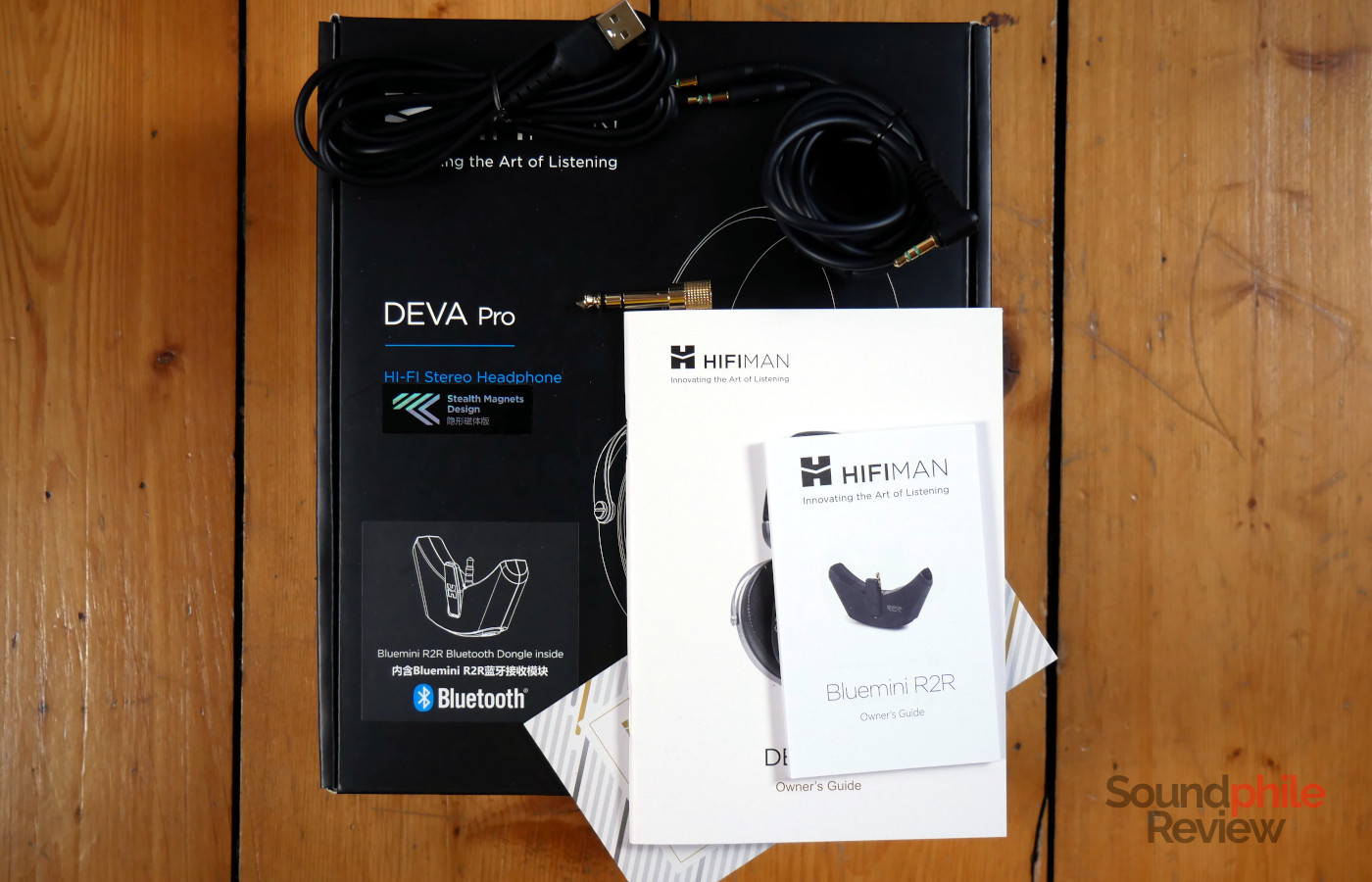
The Deva Pro comes in the usual HiFiMAN cardboard box with pre-formed foam covered in satin fabric. There’s not much in the way of accessories: there’s the Bluemini R2R and a USB to USB-C cable (in case you get the wireless version), a 3.5 mm TRS jack cable and a manual.
Design & Comfort

From a design standpoint, the Deva Pro are almost identical to the first-generation Deva. The largest difference is that the Deva Pro are silver and black, instead of silver and brown, everything else is identical. That’s a good thing, though: this design feels quite new and modern, without exceeding in that regard; in particular, the drop-like shape of the earcups is quite good-looking. It surely is different from most other headphones on the market.
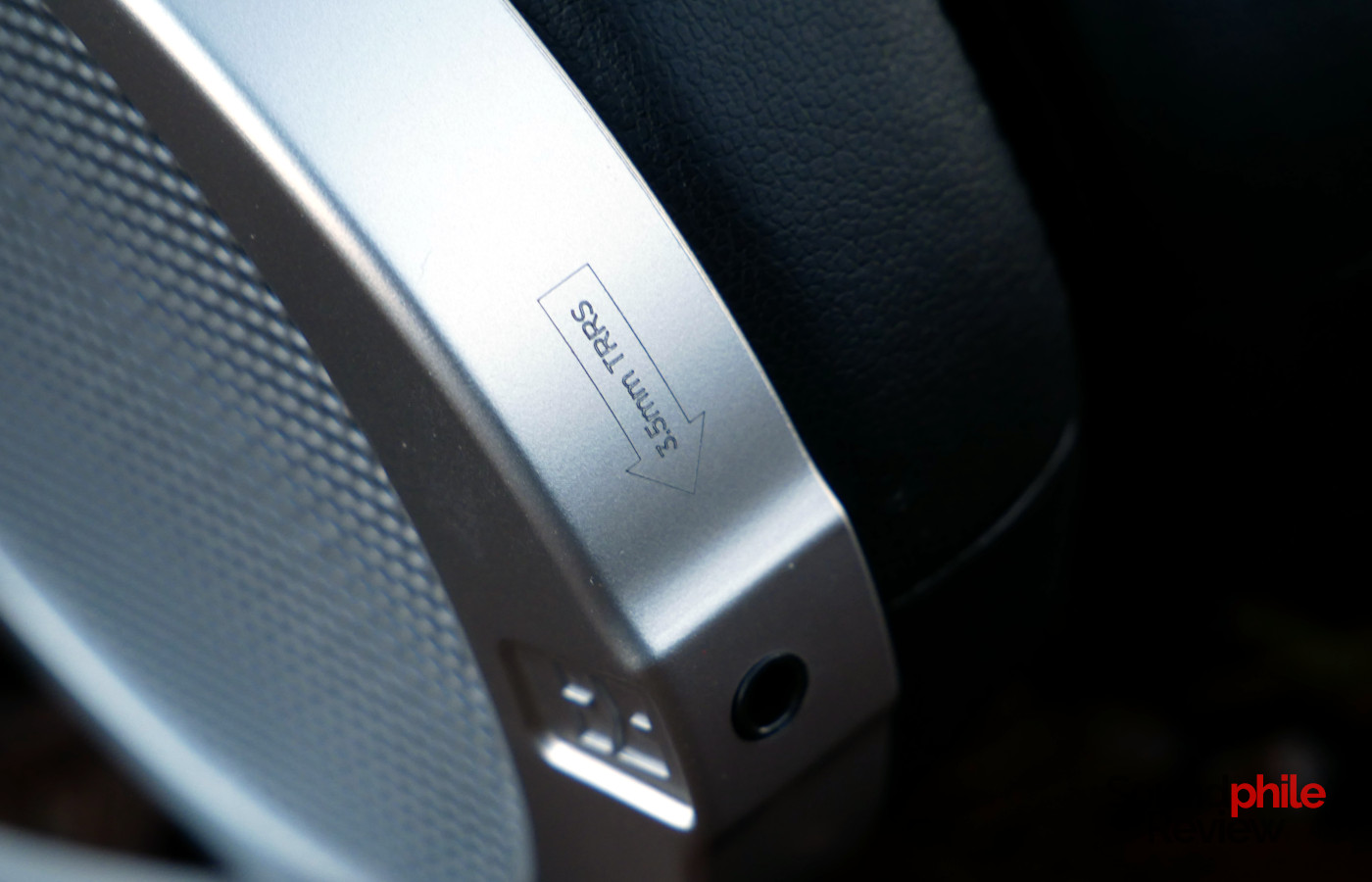
The left side is the only one that supports using the Bluemini or a single cable with a TRRS jack: if you plug those in on the right hand side, you only get that side working. There is a small label that says “3.5 mm TRRS” near the jack plug on the right hand side, but it’s hard to spot if you don’t already know it’s there – in fact the first time I tried using the Bluemini I plugged it in on the right hand side, convinced that HiFiMAN had designed the headphones smartly enough to allow the user to choose between the sides. They didn’t, which is a lost opportunity to improve usability.
Although the silver colour would induce one in thinking that the headphones are made of metal, the only parts actually made of metal are the gimbals and the grille covers: the earcups and the silver bit on the headband are made of plastic.

I found that the Deva Pro have the rather inconvenient habit of slipping forward, which means that the earpad will start pushing, albeit gently, against the back of the ears; on top of that, if you wear glasses like me they will be pushed forward, which is quite an uncomfortable sensation. This is caused by the fact that there is very little clamp, or lateral force, and this leaves the headphones free to move. By contrast, headphones with a higher clamping force like the Sennheiser HD 6XX or HiFiMAN’s own HE-560 do not display this behaviour.

In general, despite these flaws, the Deva Pro are decently comfortable even to people with very sensitive scalps like mine. The relatively low weight ( g, g with the Bluemini R2R) helps filling the gap left by the terrible headband. I can wear the Deva Pro for a couple of hours before it starts becoming problematic, which is not a bad result at all.
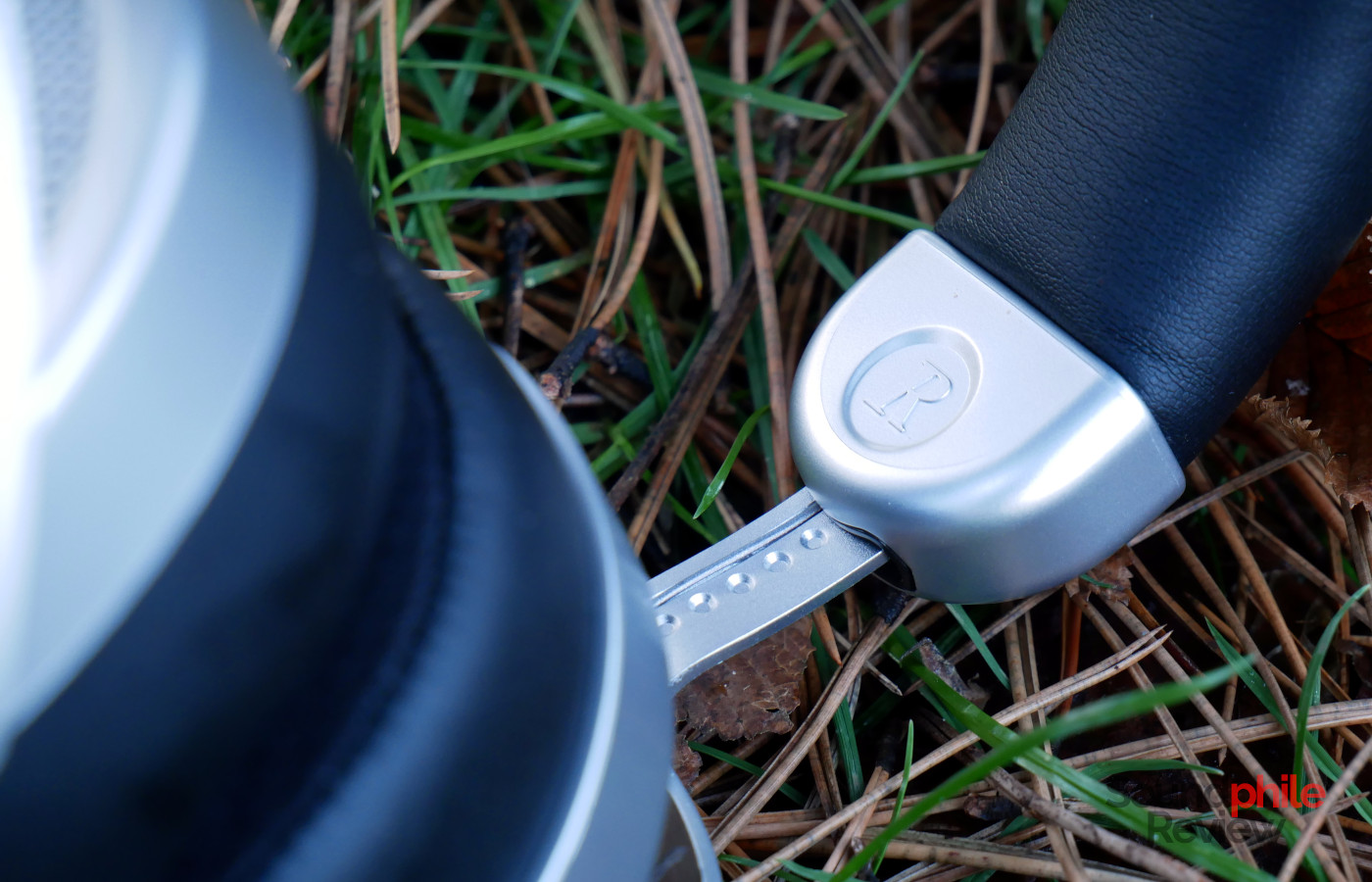
Isolation, of course, is non-existent due to the HiFiMAN Deva Pro being open-back headphones. They also leak out quite a lot of sound, so they are definitely not recommended for spaces like libraries and offices.
The cable is quite soft, but it’s the usual terrible cable that comes with HiFiMAN headphones. It has TRS 3.5 mm jacks on the headphone side, just like all other recent HiFiMAN headphones. The jack you actually plug in devices is right-angled and has a generous strain relief. The fact that both connectors on the headphone side are TRS means that you can use a balanced cable if you wish. While this cable itself is not great, I appreciate the fact that at least HiFiMAN kinda backtracked on the use of a cable that only plugs on one side, as a “stereo” cable like this (improper naming, I know, but it’s for the sake of simplicity) with 3.5 mm jacks allows you to use cables you might have from other headphones, HiFiMAN or not, as it’s quite commonly used throughout the audio industry. Let’s hope they’ll stick to this type of connectors and won’t change your mind again next year or somewhere further down the road – I have perfectly great cables I bought for my HE-560 that won’t fit here and it would be a waste if they changed standards another time.
Extra Features & Battery Life

The Bluemini R2R is a new take on the previous version that, as the name suggests, sports an R2R DAC at its heart. Just like the first model, the Bluemini R2R uses Bluetooth 5.0 and sports a number of codecs: SBC, AAC, aptX, aptX HD and LDAC; the latter is especially good as it allows for lossless transmission of music in CD quality. The range is good, but not exceptional – I can walk freely around the room, but if I get out I can only go around for a few metres before the music starts stuttering.
HiFiMAN stopped declaring technical specifications of the Bluemini R2R, only saying that its SNR is 114 dB and that its frequency response is 20 – 20,000 Hz. Of course the most important piece in this case is the DAC, as it is the new HiFiMAN Himalaya: it is an in-house design of an R2R DAC, which according to HiFiMAN is comparable to the PCM1704 in terms of THD and SNR, while consuming a lot less power (20 mW vs 450 mW).
One thing I seriously hate about the Bluemini R2R is that the status messages are way too damn loud. I can have the headphones on the other side of the room and still hear the tones or messages being played (e.g. “connected”). If I forget about this and power on the headphones when I have already worn them, I receive an ear-piercing reminder that I shouldn’t have when I turn them on. This is really infuriating as it is such a basic aspect of the user experience it’s incredible they didn’t think of this.
There are no improvements in terms of controls, as the Bluemini R2R keeps on offering very basic features – it has a single button that is used to power it on and off, as well as play and pause the music. No other command is available, which is quite limiting. While it is clearly a device made for usage while indoors and with immediate access to the source, being able to adjust the volume or skip tracks would actually be a good thing. The microphone is not great, either.
The 8 hours of battery life that HiFiMAN boasts is an almost correct figure, as I can get more or less 7 hours of playback. That’s not much by any standard, especially considering we’re talking about a full-sized headphone without the same design restrictions as closed-back counterparts that have to put all components inside the earcups. Using a larger battery would have probably been possible, even at the cost of making the Bluemini R2R a bit heavier.
It takes about 3 hours to charge the battery fully. It is possible, however, to use the headphones in the meantime by using a USB-C cable, as the Bluemini R2R works as a USB DAC as well as a Bluetooth one.
Sound & Specs
I’ve used my computers as the main sources when testing the HiFiMAN Deva Pro with Bluetooth, with mostly FLACs ripped from CDs as music files. When using the headphones wired, I used a Topping DX7 and a Drop THX AAA 789.
HiFiMAN Deva Pro |
| Frequency response | 20 – 20,000 Hz |
| Impedance | 18 Ω |
| Sensitivity | 93.5 dB |
| Bluetooth version | 5.0 |
| Codecs | SBC, AAC, aptX, aptX HD, LDAC |
The Deva Pro are the first product to be born with the new so-called “stealth magnets”, which are magnets arranged in a way that should preserve the sound produced by the diaphragm better than previous models, thanks to a reduction in refractions and diffractions. According to HiFiMAN, this causes less distortion which, in turn, creates better sound.
Although the sensitivity is very low at 93.5 dB, the impedance is very low as well at just 18 Ω, so this makes the Deva Pro easy enough to drive even with sources that offer modest power output such as phones, tablets and computers. As they are planar headphones, their impedance is constant throughout the whole range and this means that you really don’t need that powerful, special and costly amplifier to make them sound great.
Soundstage is wide enough, though it sounds as if instruments were close to your ears and then there was a large room around you, instead of the instruments actually sounding as if they were distant from you in the first place. Still, it’s a nice representation that works well. Imaging is quite good, with very accurate placement of the instruments on the stage. Instrument separation is good and allows you to tell apart all of the various pieces even in relatively crowded tracks.
Bass is not perfectly linear and therefore it doesn’t hit the lowest notes with the same strength as the rest. That said, the Deva Pro go quite deep with their bass and can be very fun with the right music, although they are just north of neutrality in general terms. Aes Dana’s Inks, as an example, does not envelope you in deep bass lines as it does with higher-end headphones by HiFiMAN (e.g. the Arya). Still, I find bass on the Deva Pro to be quite interesting, as it lays out quite a bit of detail in front of the listener and gives you a very good sense of texture. As one can legitimately expect from planar drivers, speed is quite good and transients are fast and with a short decay.
Midrange is a perfect complement to the slightly-emphasised bass and treble as it offers a very good balance, with a bit of added warmth that doesn’t take away the liveliness and clarity. It’s a very likeable, almost relaxing tuning that puts you at ease and renders basically any track with great results. What I especially like is that while it is a bit on the relaxed side, it still sounds balanced enough to reproduce basically any track with a tonality that sounds right. Mids are quite detailed, with great speed that makes for fast transients with short decay; this also means that its physicality is quite good.
Treble is bright, just like one would expect from HiFiMAN, but it’s subtly so and therefore lacks any kind of fatigue or harshness. On the contrary, despite being slightly emphasised, it is quite gentle and easy to listen to. It is also very detailed, with very minute details emerging clearly (e.g. in Aes Dana’s Alep Offset). It has very good extension as well, which gives it plenty of air and openness. I quite like the speed: highs sound crisp, with an immediacy to them that I find extremely enjoyable – and, to my surprise, not fatiguing at all. Treble is almost dry-sounding and this usually means that it becomes fatiguing, but it’s not.
HiFiMAN Deva Pro Comparisons
Unfortunately I don’t have the first-generation Deva any more, but from what I remember (and from my description in the review) it was much brighter than the Pro version. I won’t make any further comment as memory is fallible and not reliable enough (echoic memory lasting only a few seconds etc).
Final Thoughts
I quite like the HiFiMAN Deva Pro. They couldn’t be more different from their predecessors, but they have their own character that sets them apart. Contrary to most HiFiMAN headphones, they’re quite warm, without exceeding at that. They’re very enjoyable and although they don’t do anything – detail, soundstage, imaging, speed, etc – spectacularly well, they’re good enough at everything and therefore come out as a very nice middle ground. This, combined with their tonality, makes them very enjoyable with basically any music you want to listen to.
Considering they are just $30 more than the Deva, I find them spectacular. The small touches that differentiate them from their predecessors – the dual 3.5 mm jack, the black-and-silver colour scheme – are the proverbial cherry on top. If you have the chance, I warmly encourage you to try them out and hear for yourself what they sound like.

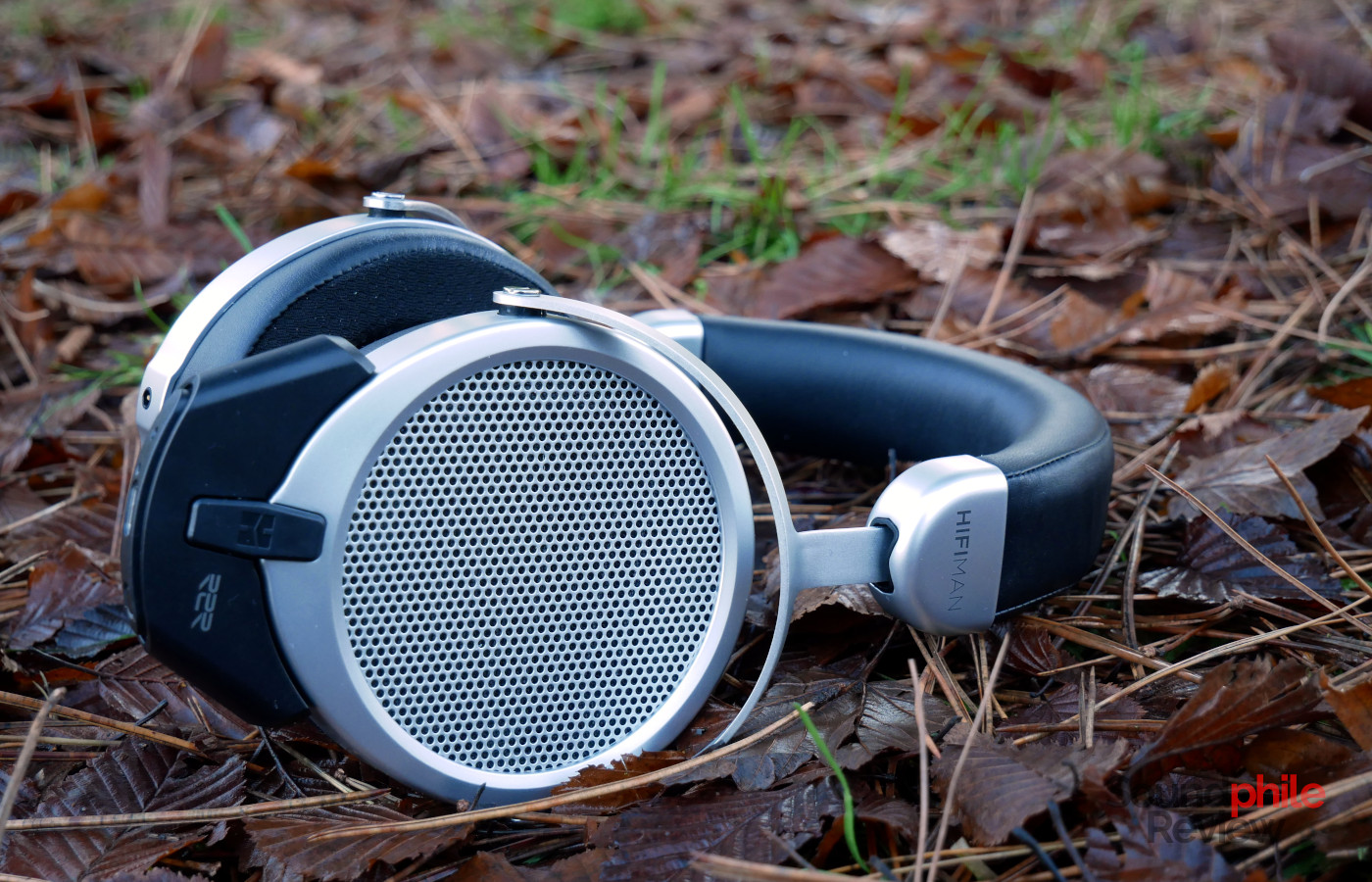




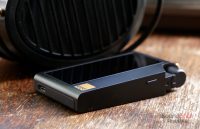


Would you recommend this or the sundara for mixing and production sessions? What if I EQ them both to reach the harman curve?
Hello Mihai,
If you EQ them, there would be no difference in frequency response obviously, but at that point I would say the Deva Pro might (and I stress this: might) have an advantage in terms of speed and detail. As I don’t have a Sundara, I can’t really test this, so it’s all quite hypothetical.
Just an FYI about a major mistake in the review! The driver cover grills on the HiFiMan Deva Pro’s are actually made out of solid metal (specifically aluminum), NOT PLASTIC as you claim!!!
It’s only the circular housing that the drivers are actually set in & which said metal grill covers are attached onto which is made of plastic!…
(Well that + the two little plastic cap pieces on each end of the headband ofc.)
PLEASE CORRECT THIS REVIEW IF POSSIBLE!!!
This is not a “major” mistake by any definition of the word, but I disassembled the driver assembly and you are right: it’s metal. It’s not aluminium though, it’s steel (it’s magnetic).
I think this is most DEFINITELY a MAJOR deal with a planar magnetic headphone!!!
(If these had dynamic drivers lol then I promise I wouldn’t care at ALL, whatsoever & sure as hell wouldn’t have wrote a comment about it.)
Why? Planar drivers (be they magnetic or electrostatic) are inherently STUPID FREAKING FRAGILE! (Caps for SERIOUS emphasis). If literally ANYTHING happens to that taut, micrometers thin diaphragm, or just as critically the solder joints to & from it, they are done. Dead. Worthless. Aka, a pile of pretty looking e-waste you can put on your head.
For example, when I was very first getting into this hobby, I once killed pair of BRAND NEW Audeze LCD-2’s (my first planar magnetic headphones ever) by running full-bore down a VERY steep & pretty long hill with them on. The intense forces being absorbed from having to stop myself from falling forward onto my face with each step messed up some of the diaphragms’ fragile solder joints & permanently killed the headphones (the driver was mostly dead, the other sounded like crap). Thankfully because they were so new, I was able to swap them out for a new pair without issue.
On the subject of driver grills SPECIFICALLY though, if they are made of plastic with any amount of flex like with say the HiFiMan’s HE400se’s, you can permanently KILL the drivers just by accidentally putting moderate pressure on the driver grills EVEN JUST ONE TIME!
With solid & thus rigid metal grills otoh? It’s basically impossible to damage the driver with external pressure on the grill unless you apply EXTREME force.
Aka/TL;DR – Proper solid metal driver grills make an absolutely GARGANTUAN DIFFERENCE for driver & thus headphone durability & longevity!!!
What you wrote would make sense if the grille was fixed to the earcup. The problem is that it is not. The grille literally lays on top of the magnet assembly and has no connection to the earcups at all, therefore it doesn’t offer any protection whatsoever from vibrations or strong force applied to the grille itself. It is only useful as a way to prevent objects from coming into contact with the driver. If you apply pressure on the grille, you apply pressure on the magnet assembly and therefore possibly on the driver itself. So it really doesn’t matter at all what kind of material they are made from, be it rubber or diamond, given that they’re going to press against the driver assembly in any case if you push them…
Also Sony’s LDAC Bluetooth codec is most definitely NOT “lossless”…
LDAC maxes out at with a 990Kbps connection… While a redbook CD or lossless FLAC file made from one otoh has a bitrate of 1411Kbps… And in case you were SOMEHOW unaware, 990Kbps < 1411Kbps… -_- …
Aka even with LDAC locked to 990Kbps mode, it's only about 70% of the way there as far as data transmission is concerned to being a TRUE "wireless lossless music experience" (which is already way, WAAAAAAAAY ahead of what any other major BT codec can do, tbf).
I suggest you look into compression, it’s quite a rabbit hole (lots of interesting maths!) and one you may find fascinating. To sum it up, though, you can get lossless with (sometimes much) less than 1.000 kbps. As a practical example, FLACs ripped from CDs are often around 900 kbps because of compression. FLAC’s average compression ratio is 70%, meaning that you get files that are 70% the size of original WAVs; if WAVs are usually around 1,400 kbps, as you correctly mentions, that means ~980 kbps – so entirely within LDAC’s capabilities. That won’t be true for every single track, but for a good portion of them LDAC is going to be able to transmit lossless music.
If I may provide you with a general suggestion on a more personal level, I recommend you do not go around and tell people they’re ignorant on a subject when you yourself clearly aren’t an expert on it.
LDAC is LITERALLY a “lossy compression Bluetooth codec”. Read the white papers, it makes it BLATANTLY explict, right from the engineers mouth’s. It’s even right on the Wiki page w/ citations if you’re too lazy for the former. Sony’s marketing department otoh is straight up LYING when they say it’s “lossless” just because PARTS of the algorithm are lossless. Other parts of the algorithm are lossy. MAKING THE ALGORITHM AS A WHOLE LOSSY!
Have fun doing some learning while having your positive, but completely & utterly faulty beliefs crushed… Sorry dude…
https://soundguys.com/ldac-ultimate-bluetooth-guide-20026/
https://en.wikipedia.org/wiki/LDAC_%28codec%29?wprov=sfla1
I really don’t want to sound rude, but when you post links, you really should make sure to read and understand them.
From SoundGuys, literally in the main points at the beginning: “The 990 and 660kbps bit rates are about as good as CD quality”. Let’s ignore that and go more into detail about dynamic range: “When someone says “CD quality,” usually what they mean is that it meets certain thresholds of performance. For example, a CD contains 16 bits of data. This gives us a theoretical noise floor of -96dB, while adding something called “dithering” improves the noise floor to somewhere around -112dB in the audible spectrum. […] Both 990 and 660kbps offer a noise floor of about -112dB (within a margin of error), right around what we’d expect for a properly-dithered CD track.”
Then let’s consider frequency response: “The 990kbps setting works as advertised. The codec transmits audio right up to 47kHz before slowly rolling off, granting it Hi-Res status. The 660kbps mode rolls off incredibly steeply at 30kHz, making it an odd middle ground between CD and Hi-Res—but that’s more than enough for most people. Both codecs roll-off at 21.5kHz when in CD mode, which is pretty much bang on the money.”
According to logic, something that has the same dynamic range and same frequency response as a CD is CD quality. If it walks like a duck…
From Wikipedia: “When the codec is set to 16 bits/44.1kHz at 909 kbps (or 16 bits/48kHz at 990 kbps) LDAC can stream lossless audio that is identical in quality to (or slightly higher than) Audio CD.”
I hope we’re done with this unproductive discussion, unless you want to point to me the parts in the LDAC encoder source code from where you can surmise that it’s a lossy codec. Here’s the code: https://android.googlesource.com/platform/external/libldac/+/refs/heads/master/src/
jesus christ that other commenter was such an insufferable person (even if he was right, which he wasnt), i always wonder when I see people talk like that online-do they talk to people in real life in the same manner whenever they feel they are right over something minor such as a headphone review?
I hope you will forgive me, but I edited out the insult and replaced it with a more neutral noun. Let’s try to keep things civil 🙂
As for your question: some people are like that only online, because they perceive it as a different “place” (there’s no face-to-face interaction) where they can vent their anger and frustration; other people are genuinely like that even in “real” life. I can only imagine how bad it must be living like that, I really don’t envy them. The world is not really kind on everyone, so compassion goes a long way. I personally just try to be kind to them anyway, even just to show them that kindness exists and that it is a viable way of living, though of course I have my limits as well!
Hi Riccardo,
Thank you for the review. Did you notice any difference in sound between the Topping, Drop and the bluetooth dongle?
I own the first Deva and wonder if the Topping would be a good match with it.
Hello Joost!
Thank you for your comment. I actually did notice that the Topping DX7 tends to be slightly warmer than the THX AAA 789 and the Bluemini, probably due to the high output impedance. Mind you, it’s a difference so subtle I’m not even sure it’s there, but I’ve heard it multiple times and this is the reason I am reporting it. I would say it is indeed a good pairing overall with the original Deva.
“..I once killed pair of BRAND NEW Audeze LCD-2’s (my first planar magnetic headphones ever) by running full-bore down a VERY steep & pretty long hill with them on. The intense forces being absorbed from having to stop myself from falling forward onto my face with each step messed up some of the diaphragms’ fragile solder joints & permanently killed the headphones..”
lol…
Leggin’ it full-pelt down a cliff face while rockin a mint set of open-back cans.
Nah that won’t end badly eh…
@Soundphilereview.com where’s the meme functionality here? Missed opportunity! …PS. nice review.
I have the Deva Pro and find your review spot on. I need a new cable and would much appreciate any advice on which configuration to go with. As I understand it, the options for balanced are (1) TRRS to TRRS and use the left input only; or (2) TRRS to 2xTRS split cable to use the dual input option. Are there actual advantages to either or is it just a matter of personal preference?
The only cable I have right now is a generic single TRRS to single TRS which works through the left chanel but I don’t think is truly balanced.
Hello Rich, it is entirely up to your personal preference. If it is TRS it is not balanced, you would need to have TRRS on the headphones side and then 2.5 mm TRRS or 4.4 mm TRRRS on the other.